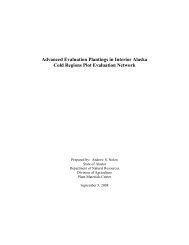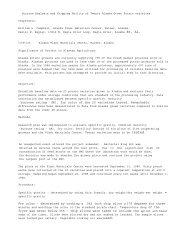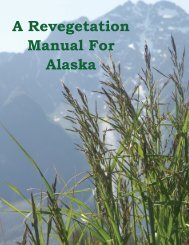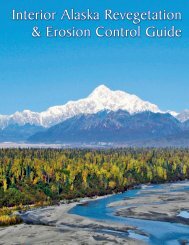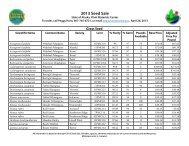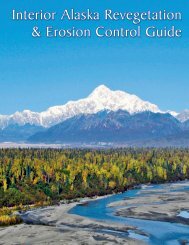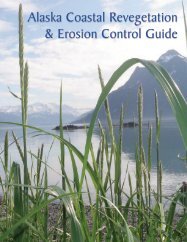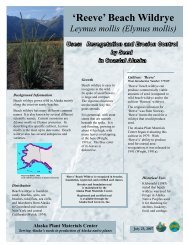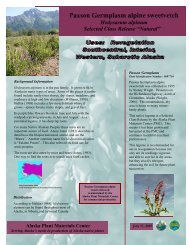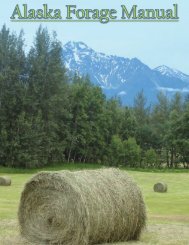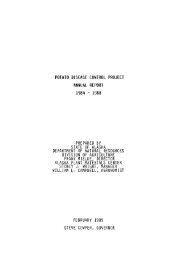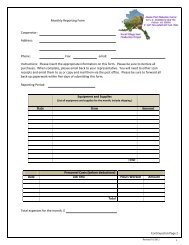Alaska Forage Manual - Alaska Plant Materials Center - State of ...
Alaska Forage Manual - Alaska Plant Materials Center - State of ...
Alaska Forage Manual - Alaska Plant Materials Center - State of ...
You also want an ePaper? Increase the reach of your titles
YUMPU automatically turns print PDFs into web optimized ePapers that Google loves.
POLARGRASS<br />
find Polargrass to be as palatable as grazing animals like cattle,<br />
bison and elk. As with most grasses, the nutritional value <strong>of</strong><br />
Polargrass diminishes substantially after seed development or<br />
without adequate moisture.<br />
Distribution and Adaptation<br />
Polargrass is adapted to cool, wet climates, and is found<br />
growing along rivers, meadows, tundra, fresh water marshes,<br />
and inland levees. It is adapted to cold boggy soils and/or<br />
mesic up lands. This grass will grow well in soils with a pH<br />
ranging from 4.9 to 6.8. Polargrass is intolerant to droughty<br />
and/or saline environments. It prefers northern latitudes and<br />
can be found growing in portions <strong>of</strong> Greenland, Canada, and<br />
<strong>Alaska</strong>.<br />
Photo: <strong>Alaska</strong> PMC<br />
Polargrass, Arctagrostis latifolia<br />
Polargrass<br />
Arctagrostis latifolia (L.)<br />
Description<br />
Arctagrostis latifolia (Polargrass) is a long lived, cool season,<br />
perennial, sod forming grass. It grows erect culms 45 to 60<br />
centimeters (18 to 24 inches) tall. Polargrass leaves vary in<br />
length from a few inches to a foot and are usually 6 to 13 mm<br />
( 1 /4 - 1 /2 inch) wide. Inflorescence (seed-head) is narrow to<br />
somewhat open panicle 8 to 28 cm (3 to 11 inches) in length.<br />
Polargrass has low seedling vigor and produces a small seed<br />
with about 1,800,000 seeds per pound <strong>of</strong> seed.<br />
Uses<br />
Livestock: Polargrass can be used for pasture, hay, or silage.<br />
This grass is capable <strong>of</strong> generating high yields and can provide<br />
livestock with adequate forage and nutrition.<br />
Wildlife: Polargrass has shown to provide good forage for<br />
caribou and reindeer in northern regions throughout Canada<br />
and <strong>Alaska</strong>. Grizzly bears have been observed grazing large<br />
quantities <strong>of</strong> polargrass during spring and summer months. It<br />
also provides cover and forage for small mammals and various<br />
song birds.<br />
<strong>Forage</strong> Value<br />
Polargrass produces large amounts <strong>of</strong> protein and is a high<br />
quality forage for large grazing animals. It possesses good<br />
nutritional value and digestibility similar to that <strong>of</strong> Timothy<br />
(Phleum pratense). Browsers such as moose and deer do not<br />
Culture<br />
Polargrass seed should be planted ¼ to ½ inch deep. Low<br />
seedling vigor can make this grass difficult to establish. Seeding<br />
rates depend greatly upon soil type, moisture, and location.<br />
An average seeding rate when broadcasting Polargrass is 8 lbs/<br />
acre and 5 lbs/acre when drill seeding. Seeding Polargrass<br />
as part <strong>of</strong> a mix is not recommended because <strong>of</strong> the grass’s<br />
weak ability to compete with other plants. All seeding rates<br />
are determined by using Pure Live Seed (PLS) calculations, as<br />
described in Appendix B.<br />
Appropriate fertilizer ratios depend upon soil type, chemistry,<br />
and location. Soil samples should be collected and analyzed<br />
before fertilizer is applied. Pastures and hay fields should<br />
be irrigated when necessary. Irrigation in combination with<br />
fertilization should increase overall yields.<br />
Management<br />
Polargrass seedling vigor is poor and early growth rates<br />
are usually slow. It requires an environment with low<br />
competition, moderate moisture, and adequate nutrients.<br />
However, once Polargrass is established, it has early and<br />
vigorous spring growth. Production trials <strong>of</strong> unfertilized vs.<br />
fertilized Polargrass have shown the differences in yield to<br />
be insignificant, suggesting that Polargrass does not respond<br />
well to commercial fertilizers. More research needs to be<br />
conducted to validate this theory, however.<br />
Polargrass requires moderate amounts <strong>of</strong> moisture and<br />
should be irrigated when applicable. Arctagrostis latifolia is<br />
an extremely winter hardy grass, with a greater tolerance to<br />
winter ponding and icy conditions than other forage grasses<br />
like Timothy (Phleum pratense) and Smooth Brome (Bromus<br />
inermis).<br />
47



